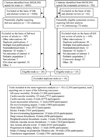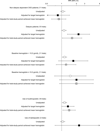Dose of erythropoiesis-stimulating agents and adverse outcomes in CKD: a metaregression analysis
- PMID: 22921639
- PMCID: PMC3525813
- DOI: 10.1053/j.ajkd.2012.07.014
Dose of erythropoiesis-stimulating agents and adverse outcomes in CKD: a metaregression analysis
Abstract
Background: Targeting higher hemoglobin levels with erythropoiesis-stimulating agents (ESAs) to treat the anemia of chronic kidney disease (CKD) is associated with increased cardiovascular risk.
Study design: Metaregression analysis examining the association of ESA dose with adverse outcomes independent of target or achieved hemoglobin level.
Setting & population: Patients with anemia of CKD irrespective of dialysis status.
Selection criteria for studies: We searched MEDLINE (inception to August 2010) and bibliographies of published meta-analyses and selected randomized controlled trials assessing the efficacy of ESAs for the treatment of anemia in adults with CKD, with a minimum 3-month duration. Two authors independently screened citations and extracted relevant data. Individual study arms were treated as cohorts and constituted the unit of analysis.
Predictors: ESA dose standardized to a weekly epoetin alfa equivalent, and hemoglobin levels.
Outcomes: All-cause and cardiovascular mortality, cardiovascular events, kidney disease progression, or transfusion requirement.
Results: 31 trials (12,956 patients) met the criteria. All-cause mortality was associated with higher (per epoetin alfa-equivalent 10,000-U/wk increment) first-3-month mean ESA dose (incidence rate ratio [IRR], 1.42; 95% CI, 1.10-1.83) and higher total-study-period mean ESA dose (IRR, 1.09; 95% CI, 1.02-1.18). First-3-month ESA dose remained significant after adjusting for first-3-month mean hemoglobin level (IRR, 1.48; 95% CI, 1.02-2.14), as did total-study-period mean ESA dose adjusting for target hemoglobin level (IRR, 1.41; 95% CI, 1.08-1.82). Parameter estimates between ESA dose and cardiovascular mortality were similar in magnitude and direction, but not statistically significant. Higher total-study-period mean ESA dose also was associated with increased rate of hypertension, stroke, and thrombotic events, including dialysis vascular access-related thrombotic events.
Limitations: Use of study-level aggregated data; use of epoetin alfa-equivalent doses; lack of adjustment for confounders.
Conclusions: In patients with CKD, higher ESA dose might be associated with all-cause mortality and cardiovascular complications independent of hemoglobin level.
Copyright © 2012 National Kidney Foundation, Inc. Published by Elsevier Inc. All rights reserved.
Figures




Comment in
-
Erythropoiesis-stimulating agents on trial: are higher dosages causing harm?Am J Kidney Dis. 2013 Jan;61(1):6-8. doi: 10.1053/j.ajkd.2012.10.004. Am J Kidney Dis. 2013. PMID: 23245737 No abstract available.
References
-
- Leaf DE, Goldfarb DS. Interpretation and review of health-related quality of life data in CKD patients receiving treatment for anemia. Kidney Int. 2009 Jan;75(1):15–24. - PubMed
-
- Jones M, Ibels L, Schenkel B, Zagari M. Impact of epoetin alfa on clinical end points in patients with chronic renal failure: a meta-analysis. Kidney Int. 2004 Mar;65(3):757–767. - PubMed
-
- Rao M, Pereira BJ. Optimal anemia management reduces cardiovascular morbidity, mortality, and costs in chronic kidney disease. Kidney Int. 2005 Oct;68(4):1432–1438. - PubMed
-
- Vlagopoulos PT, Tighiouart H, Weiner DE, et al. Anemia as a risk factor for cardiovascular disease and all-cause mortality in diabetes: the impact of chronic kidney disease. J Am Soc Nephrol. 2005 Nov;16(11):3403–3410. - PubMed
-
- Locatelli F, Pisoni RL, Combe C, et al. Anaemia in haemodialysis patients of five European countries: association with morbidity and mortality in the Dialysis Outcomes and Practice Patterns Study (DOPPS) Nephrol Dial Transplant. 2004 Jan;19(1):121–132. - PubMed
Publication types
MeSH terms
Substances
Grants and funding
LinkOut - more resources
Full Text Sources
Other Literature Sources
Medical
Miscellaneous

